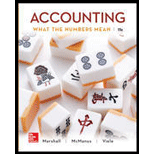
Concept explainers
Concept Introduction:
Accounting equation represents the mathematical relationship between assets, liabilities and equity. According to this equation, assets are equal to the sum of liabilities and equity. The formal for basic accounting equation is as follows:
Requirement-1:
To indicate:
The effect of the purchase of supplies as expense using the horizontal model
Concept Introduction:
Adjusting entries: The adjusting entries are recorded at the end to each accounting period to adjust the account as per the accrual concept of accounting. The adjusting entries include adjustment of depreciation, adjustment of payable expenses, and adjustment of receivable revenue.
Accounting equation represents the mathematical relationship between assets, liabilities and equity. According to this equation, assets are equal to the sum of liabilities and equity. The formal for basic accounting equation is as follows:
Requirement-2:
To indicate:
The effect of the adjustment for supplies using the horizontal model
Concept Introduction:
Adjusting entries: The adjusting entries are recorded at the end to each accounting period to adjust the account as per the accrual concept of accounting. The adjusting entries include adjustment of depreciation, adjustment of payable expenses, and adjustment of receivable revenue.
Accounting equation:
Accounting equation represents the mathematical relationship between assets, liabilities and equity. According to this equation, assets are equal to the sum of liabilities and equity. The formal for basic accounting equation is as follows:
Requirement-3:
To indicate:
The effect of the alternative way of recording the supplies purchase using the horizontal model
Concept Introduction:
Adjusting entries: The adjusting entries are recorded at the end to each accounting period to adjust the account as per the accrual concept of accounting. The adjusting entries include adjustment of depreciation, adjustment of payable expenses, and adjustment of receivable revenue.
Accounting equation:
Accounting equation represents the mathematical relationship between assets, liabilities and equity. According to this equation, assets are equal to the sum of liabilities and equity. The formal for basic accounting equation is as follows:
Requirement-d:
To indicate:
The effect of the adjustment required using the alternative way of recording the supplies purchase using the horizontal model
Concept Introduction:
Adjusting entries: The adjusting entries are recorded at the end to each accounting period to adjust the account as per the accrual concept of accounting. The adjusting entries include adjustment of depreciation, adjustment of payable expenses, and adjustment of receivable revenue.
Accounting equation:
Accounting equation represents the mathematical relationship between assets, liabilities and equity. According to this equation, assets are equal to the sum of liabilities and equity. The formal for basic accounting equation is as follows:
Requirement-e:
To indicate:
The effect of the above two different set of ways to record the supplies expense on the income statement and the
Want to see the full answer?
Check out a sample textbook solution
Chapter 4 Solutions
Accounting: What the Numbers Mean
- What are two double entries the following transaction? Account Receivable. Account payable. Rent Expenses. Cell phone bill, cable, light bill, gas, and monthly income of $4,000.00 what will be your net income after all expenses are paid. Please figure out your own price for each expense.arrow_forwardCan you solve this general accounting problem using appropriate accounting principles?arrow_forwardCan you help me solve this general accounting question using the correct accounting procedures?arrow_forward
- I need the correct answer to this general accounting problem using the standard accounting approach.arrow_forwardI need help solving this general accounting question with the proper methodology.arrow_forwardI need the correct answer to this general accounting problem using the standard accounting approach.arrow_forward
- Can you solve this general accounting question with the appropriate accounting analysis techniques?arrow_forwardPlease explain the solution to this general accounting problem with accurate principles.arrow_forwardPlease explain the solution to this general accounting problem with accurate principles.arrow_forward

 AccountingAccountingISBN:9781337272094Author:WARREN, Carl S., Reeve, James M., Duchac, Jonathan E.Publisher:Cengage Learning,
AccountingAccountingISBN:9781337272094Author:WARREN, Carl S., Reeve, James M., Duchac, Jonathan E.Publisher:Cengage Learning, Accounting Information SystemsAccountingISBN:9781337619202Author:Hall, James A.Publisher:Cengage Learning,
Accounting Information SystemsAccountingISBN:9781337619202Author:Hall, James A.Publisher:Cengage Learning, Horngren's Cost Accounting: A Managerial Emphasis...AccountingISBN:9780134475585Author:Srikant M. Datar, Madhav V. RajanPublisher:PEARSON
Horngren's Cost Accounting: A Managerial Emphasis...AccountingISBN:9780134475585Author:Srikant M. Datar, Madhav V. RajanPublisher:PEARSON Intermediate AccountingAccountingISBN:9781259722660Author:J. David Spiceland, Mark W. Nelson, Wayne M ThomasPublisher:McGraw-Hill Education
Intermediate AccountingAccountingISBN:9781259722660Author:J. David Spiceland, Mark W. Nelson, Wayne M ThomasPublisher:McGraw-Hill Education Financial and Managerial AccountingAccountingISBN:9781259726705Author:John J Wild, Ken W. Shaw, Barbara Chiappetta Fundamental Accounting PrinciplesPublisher:McGraw-Hill Education
Financial and Managerial AccountingAccountingISBN:9781259726705Author:John J Wild, Ken W. Shaw, Barbara Chiappetta Fundamental Accounting PrinciplesPublisher:McGraw-Hill Education





